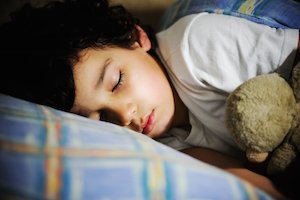Sleep apnea is a serious and sometimes life-threatening condition in which breathing is interrupted during sleep. Although it often affects overweight men, sleep apnea can occur in women, men who are not overweight, and children.
 Like adults, children who have sleep apnea can stop breathing for a minute or more as often as a 50 times a night. When breathing stops, oxygen levels in the blood fall. For this reason, children with sleep apnea are at risk for headaches, poor daytime functioning, high blood pressure (hypertension), irreversible neurologic problems, learning disabilities, hyperactivity, and aggressive behavior. For these reasons, it is important to see a doctor if your child snores or has sleep apnea symptoms.
Like adults, children who have sleep apnea can stop breathing for a minute or more as often as a 50 times a night. When breathing stops, oxygen levels in the blood fall. For this reason, children with sleep apnea are at risk for headaches, poor daytime functioning, high blood pressure (hypertension), irreversible neurologic problems, learning disabilities, hyperactivity, and aggressive behavior. For these reasons, it is important to see a doctor if your child snores or has sleep apnea symptoms.
The American Academy of Pediatrics recommends a sleep study (polysomnogram) for every child who snores.
Types of Sleep Apnea
- Obstructive sleep apnea (OSA) — a common condition that occurs when muscles inside the throat relax and cause tissue at the back of the throat to collapse, block the airway, and prevent air from getting to the lungs
- Central sleep apnea is less common than OSA. It occurs when the brain does not signal the lungs to take in air and oxygen
Sleep apnea can occur in otherwise healthy infants, toddlers, children, and teens.
Symptoms of Sleep Apnea in Children Include:
- Loud, irregular snoring
- Daytime sleepiness
- Headaches in the morning
- Irritability and behavioral problems
- Poor performance at school
- Weight gain, overweight, and obesity
- Frequent nighttime urination
- Bed wetting
- High blood pressure (hypertension)
- Diabetes
- Hyperactivity
Risk for Obstructive Sleep Apnea in Children Includes:
- Allergies
- Being obese
- Chronic sinusitis
- Deviated nasal septum
- Enlarged tonsils
- Enlarged adenoids
- Genetic disorders
- Large tongue
- Lung problems
- Neurologic disorders
- Small jaw
- Tissue that blocks the upper airway
Evaluating Sleep Apnea in your Child
In some cases, children with sleep apnea symptoms have a noninvasive sleep study to monitor and evaluate sleep patterns. Sleep studies allow experts to examine physiologic patterns during sleep to determine how best to treat and manage sleep apnea.
The good news is that sleep apnea can be effectively treated!
Sleep Studies in Children Measure:
- Brain waves
- Breathing, snoring, and other noises
- Eye movement
- Heart rate
- Leg movement
- Oxygen and carbon dioxide levels in the blood
- pH
Treating Sleep Apnea in a Child
Depending on your child’s age as well as causes for his or her sleep apnea, treatment can include:
- Tonsil and adenoid surgery (tonsillectomy and adenoidectomy) to remove the tonsils and adenoids and open the airway
- Continuous positive airway pressure (CPAP), which involves placing a mask connected to an air compressor over the nose that forces air through the nasal passages, keeping them open, preventing snoring, preventing the airway from being obstructed, and ensuring enough oxygen gets in the blood to help a child cycle through sleep stages, wake refreshed, and be alert during the day
- Bi-level therapy, which offers 2 air pressures — a higher level when breathing in and a lower level when breathing out to open nasal passages, prevent snoring, keep the airway open, and ensure enough oxygen gets in the blood. Bi-level therapy is especially useful for people with central sleep apnea, including COPD. Bi-level therapy can help reduce carbon dioxide levels in the blood during sleep
- Weight loss in children who are overweight and obese. Research shows that many overweight and obese children experience obstructive sleep apnea. Some data suggest that children who are prone to obstructive sleep apnea can greatly reduce severity of the condition with weight loss
